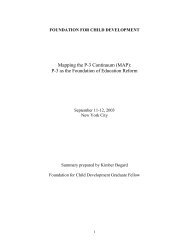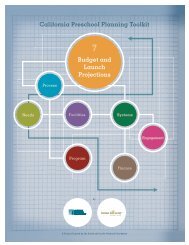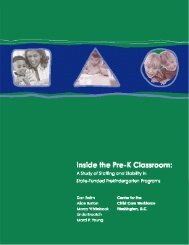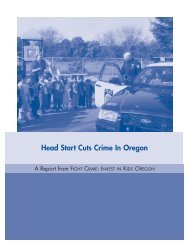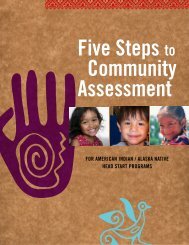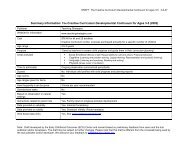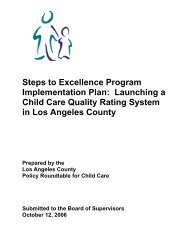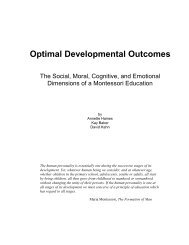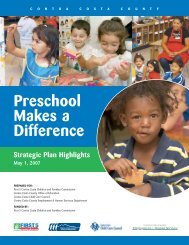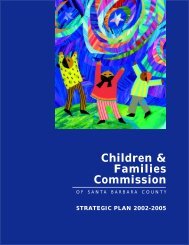Download this file - Plan4Preschool
Download this file - Plan4Preschool
Download this file - Plan4Preschool
You also want an ePaper? Increase the reach of your titles
YUMPU automatically turns print PDFs into web optimized ePapers that Google loves.
Year-Round Education <br />
As of October 2005, 19 percent of kindergarten through grade twelve public school<br />
students were attending 1,430 schools that operated year-round schedules in 156<br />
school districts.<br />
The effect, in terms of new school construction dollars saved as a result of multitrack,<br />
year-round education operation, is impressive. If 20 percent of the 700,141 multitrack,<br />
year-round education students are housed in excess of capacity at their school sites,<br />
then more than $2.2 billion in construction costs is avoided by the state and local school<br />
districts.<br />
Year-round education is an alternative way to construct the school calendar. Both<br />
traditional and year-round school calendars have approximately 180 days of instruction,<br />
or the same number of instructional minutes, but year-round calendars spread<br />
instructional and vacation periods throughout the year. For example, the most typical<br />
instructional/vacation year-round pattern is called the “60/20 calendar,” 60 days of<br />
instruction followed by 20 days of vacation, repeated three times during the school year.<br />
Year-round education can be single-track or multitrack. A single-track, year-round<br />
calendar simply changes the instructional/vacation sequence of the school year. All the<br />
students and staff are in school or on vacation at the same time. But a multitrack, yearround<br />
calendar does something quite different. It divides the entire student body and<br />
staff into four or five different tracks. A school using a four-track system has, at any one<br />
time, three of the four tracks attending school while the fourth track is on vacation.<br />
When the fourth track of students returns from vacation, another track leaves. Thus, the<br />
student population rotates in and out of school, one track replacing another on vacation,<br />
which allows the enrollment of the school to exceed its capacity.<br />
It is possible to have a three-track, multitrack, year-round education calendar, called a<br />
Concept 6 calendar. Because <strong>this</strong> calendar has only 163 instructional days per year,<br />
schools presently using Concept 6 have until 2012 to find alternative ways to house<br />
students in excess of capacity. Schools not using Concept 6 calendars cannot adopt<br />
<strong>this</strong> calendar.<br />
Possible advantages associated with single-track, year-round education include its<br />
potential to (1) improve academic achievement by eliminating summer regression;<br />
(2) relieve teacher and student burnout; (3) provide new opportunities for teacher<br />
training; and (4) offer frequent remedial and enrichment programs during intersessions.<br />
However, as administrators try to achieve these potential benefits, they are faced with a<br />
number of challenges. For example, coordinating family vacations, maintaining full<br />
extracurricular and athletic programs, and lengthening the instructional year require<br />
sophisticated and sensitive planning.<br />
121



